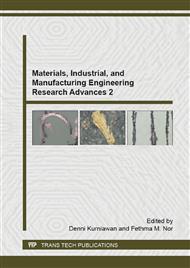p.411
p.416
p.421
p.426
p.432
p.437
p.441
p.445
p.450
Design of Above-Knee Prosthesis: A Finite Element Stress Analysis
Abstract:
In the present research, three-dimensional models of above-knee prosthesis, consist of socket, four-bar linkage knee, pylon and foot, are developed. These models have to fulfill criteria such as stability, ability to withstand up to 90 kg of bodyweight, ability to flex up to 130 degree, easy for maintenance, simple manufacturing process, affordable and yet reliable. As the first step of development, these models were evaluated using finite element method software to determine whether or not the design has fulfilled strength criteria. The results show that the last iteration of the three dimensional model of the knee prosthesis has satisfied the criteria.
Info:
Periodical:
Pages:
432-436
Citation:
Online since:
October 2015
Keywords:
Price:
Сopyright:
© 2015 Trans Tech Publications Ltd. All Rights Reserved
Share:
Citation:


